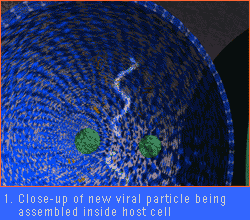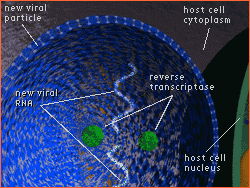
|
 |
 |
Viral Entry | Viral Gene Transfer | Viral Exit
This sequence shows a new viral particle being assembled and then migrating out of the host cell to infect new cells. Once the viral protein parts have been built, they are assembled into a new HIV particle. This particle is an exact duplicate of the HIV particle from which it sprung, complete with two copies of viral RNA and the enzymes needed for reverse transcription. The new HIV particle moves out of the cell, where it heads off to infect another cell and perpetuate the life cycle. This process repeats itself continuously, with many thousands of HIV particles produced simultaneously in the body. After repeated assaults by viral particles, host cells die, having exhausted their energy and molecular building supplies while generating HIV viruses. This suppresses a patient's immune system and leaves him or her open to infection by other infectious agents, including bacteria, fungi, and other viruses. Viral Entry | Viral Gene Transfer | Viral Exit Search for a Vaccine | See HIV in Action | AIDS in Perspective The Virus Fighters | Fighting Back | Help/Resources Teacher's Guide | Transcript | Site Map | Surviving AIDS Home Editor's Picks | Previous Sites | Join Us/E-mail | TV/Web Schedule About NOVA | Teachers | Site Map | Shop | Jobs | Search | To print PBS Online | NOVA Online | WGBH © | Updated October 2000 |

